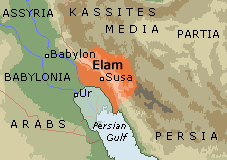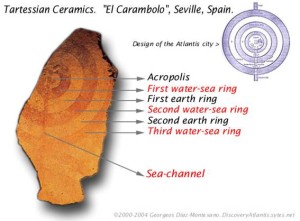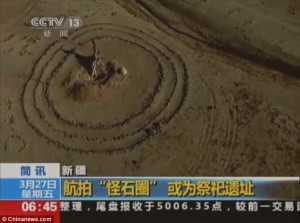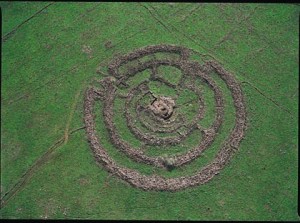Susa
Susa (L)
Susa is the name of a 6,000-year-old site in modern Iran that was once the capital of the Elamite Empire. In his m ost recent book[877] Jim Allen has speculated that Susa was one of the cities of ancient Persia that may have inspired Plato’s description of the capital city of Atlantis. August Hunt goes further and clearly identifies[747.170] Susa as Atlantis.
ost recent book[877] Jim Allen has speculated that Susa was one of the cities of ancient Persia that may have inspired Plato’s description of the capital city of Atlantis. August Hunt goes further and clearly identifies[747.170] Susa as Atlantis.
Concentric Rings *
The Concentric Rings or other architectural features extracted by artists from Plato’s description of the capital of Atlantis have  continually fascinated students of the story and many have attempted to link them with similar ancient features found elsewhere in the world as evidence of a widespread culture. Stonehenge, Old Owstrey, Carthage and Syracuse have all been suggested, but such comparisons have never been convincing. Diaz-Montexano has recently published(a) an image of a fragment of pottery found near Seville in Spain that shows concentric circles and insists that it is a symbol of Atlantis. Ulf Erlingsson has made a similar claim regarding some concentric circles carved on a stone basin found at Newgrange in Ireland.
continually fascinated students of the story and many have attempted to link them with similar ancient features found elsewhere in the world as evidence of a widespread culture. Stonehenge, Old Owstrey, Carthage and Syracuse have all been suggested, but such comparisons have never been convincing. Diaz-Montexano has recently published(a) an image of a fragment of pottery found near Seville in Spain that shows concentric circles and insists that it is a symbol of Atlantis. Ulf Erlingsson has made a similar claim regarding some concentric circles carved on a stone basin found at Newgrange in Ireland.
Less well-known are the concentric stone circles that are to be found on the island of Lampedusa in the Strait of Sicily(b).
In 1969 two commercial pilots, Robert Brush and Trigg Adams photographed a series of large concentric circles in about three feet of water off the coast of Andros in the Bahamas. Estimates of the diameter of the circles range from 100 to 1,000 feet. Apparently, these rings are now covered by sand. It is hard to understand how such a feature in such very shallow water cannot be physically located and inspected. Richard Wingate in his book [0059] estimated the diameter at 1,000 yards. However, the rings described by Wingate were apparently on land, among Andros’ many swamps.
A recent (2023) report has drawn attention to the ancient rock art found on Kenya’s Mfangano Island where a number of concentric circles estimated as 4,000 years old can be seen(q).
Two papers presented to the 2005 Atlantis Conference on Melos describe how an asteroid impact could produce similar concentric rings, which, if located close to a coast, could be converted easily to a series of canals for seagoing vessels. The authors, Filippos Tsikalas, V.V. Shuvavlov and Stavros Papamarinopoulos gave examples of such multi-ringed concentric morphology resulting from asteroid impacts. Not only does their suggestion provide a rational explanation for the shape of the canals but would also explain the apparent over-engineering of those waterways.
At the same conference, the late Ulf Richter presented his idea [629.451], which included the suggestion that the concentric rings around the centre of the Atlantis capital had a natural origin. Richter has proposed that the Atlantis rings were the result of the erosion of an elevated salt dome that had exposed alternating rings of hard and soft rock that could be adapted to provide the waterways described by Plato.
Georgeos Diaz-Montexano has suggested that the ancient city under modern Jaen in Andalusia, Spain had a concentric layout similar to Plato’s description of Atlantis. In August 2016 archaeologists from the University of Tübingen revealed the discovery(i) of a Copper Age, Bell Beaker People site 50km east of Valencina near Seville, where the complex included a series of concentric earthwork circles.
A very impressive example of man-made concentric stone circles, known in Arabic as Rujm el-Hiri and in Hebrew as Gilgal Refaim(a), is to be found on the Golan Heights, now part of Israeli-occupied Syria. It consists of four concentric walls with an outer diameter of 160metres. It has been dated to 3000-2700 BC and is reputed to have been built by giants! Mercifully, nobody has claimed any connection with Atlantis. That is until 2018 when Ryan Pitterson made just such a claim in his book, Judgement of the Nephilim[1620].
Jim Allen in his latest book, Atlantis and the Persian Empire[877], devotes a well-illustrated chapter to a discussion of a number of ‘circular cities’ that existed in ancient Persia and which some commentators claim were the inspiration for Plato’s description of the city of Atlantis. These include the old city of Firuzabad which was divided into 20 sectors by radial spokes as well as Ecbatana and Susa, both noted by Herodotus to have had concentric walls. Understandably, Allen, who promotes the idea of Atlantis in the Andes, has pointed out that many sites on the Altiplano have hilltops surrounded by concentric walls. However, as he seems to realise that to definitively link any of these locations with Plato’s Atlantis a large dollop of speculation was required.
Rodney Castleden compared the layout of Syracuse in Sicily with Plato’s Atlantis noting that the main city “had seen a revolution in its defensive works, with the building of unparalleled lengths of circuit walls punctuated by numerous bastions and towers, displaying the city-state’s power and wealth. The three major districts of the city, Ortygia, Achradina and Tycha, were surrounded by three separate circuit walls; Ortygia itself had three concentric walls, a double wall around the edge and an inner citadel”.[225.179]
Dale Drinnon has an interesting article(d) on the ‘rondels’ of the central Danubian region, which number about 200. Some of these Neolithic features have a lot in common with Plato’s description of the port city of Atlantis. The ubiquity of circular archaeological structures at that time is now quite clear, but they do not demonstrate any relationship with Atlantis.
The late Marcello Cosci based his Atlantis location on his interpretation of aerial images of circular features on Sherbro Island, but as far as I can ascertain this idea has gained little traction.
One of the most remarkable natural examples of concentric features is to be found in modern Mauritania and is known as the Richat Structure or Guelb er Richat. It is such a striking example that it is not surprising that some researchers have tried to link it with Atlantis. Robert deMelo and Jose D.C. Hernandez(o) are two advocates along with George S. Alexander & Natalis Rosen who were struck by the similarity of the Richat feature with Plato’s description and decided to investigate on the ground. Instability in the region prevented this until late 2008 when they visited the site, gathering material for a movie. The film was then finalised and published on their then newly established website in 2010(l), where the one hour video in support of their thesis can be freely downloaded(m).
In 2008, George Sarantitis put forward the idea that the Richat Structure was the location of Atlantis, supporting his contention with an intensive reappraisal of the translation of Plato’s text(n). He developed this further in his Greek language 2010 book, The Apocalypse of a Myth[1470] with an English translation currently in preparation.
However, Ulf Richter has pointed out that Richat is too wide (35 km), too elevated (400metres) and too far from the sea (500 km) to be seriously considered as the location of Atlantis.
A dissertation by Oliver D.Smith has suggested(e) the ancient site of Sesklo in Greece as the location of Atlantis, citing its circularity as an important reason for the identification. However, there are no concentric walls, the site is too small and most importantly, it’s not submerged. Smith later decided that the Atlantis story was a fabrication!(p)
Brad Yoon has claimed that concentric circles are proof of the existence of Atlantis, an idea totally rejected by Jason Colavito(j).
In March 2015, the UK’s MailOnline published a generously illustrated article(g) concerning a number of sites with unexplained concentric circles in China’s Gobi Desert. The article also notes some  superficial similarities with Stonehenge. I will not be surprised if a member of the lunatic fringe concocts an Atlantis theory based on these images. (see right)
superficial similarities with Stonehenge. I will not be surprised if a member of the lunatic fringe concocts an Atlantis theory based on these images. (see right)
Paolo Marini has written Atlantide:Nel cerchio di Stonehenge la chiave dell’enigma (Atlantis: The Circle is the Key to the enigma of Stonehenge) [0713]. The subtitle refers to his contention that the concentric circles of Atlantis are reflected in the layout of Stonehenge!
In 2011 Shoji Yoshinori offered the suggestion that Stonehenge was a 1/24th scale model of Atlantis(f). He includes a fascinating image in the pdf.
This obsession with concentricity has now extended to the interpretation of ancient Scandinavian armoury in particular items such as the Herzsprung Shield(c).
For my part, I wish to question Plato’s description of the layout of Atlantis’ capital city with its vast and perfectly engineered concentric alternating bands of land and sea. This is highly improbable as the layout of cities is invariably determined by the natural topography of the land available to it(h). Plato is describing a city designed by and for a god and his wife and as such his audience would expect it to be perfect and Plato did not let them down. I am therefore suggesting that those passages have been concocted within the parameters of ‘artistic licence’ and should be treated as part of the mythological strand in the narrative, in the same way, that we view the ‘reality’ of Clieto’s five sets of male twins or even the physical existence of Poseidon himself.
Furthermore, Plato was a follower of Pythagoras, who taught that nothing exists without a centre, around which it revolves(k). A concept which may have inspired him to include it in his description of Poseidon’s Atlantis.
(b) Megalithic Lampedusa (archive.org)
(c) https://www.parzifal-ev.de/index.php?id=20
(d) See: Archive 3595
(e) https://atlantipedia.ie/samples/archive-3062/
(f) https://www.pipi.jp/~exa/kodai/kaimei/stonehenge_is_small_atrantis_eng.pdf
(i) First Bell Beaker earthwork enclosure found in Spain | ScienceDaily (archive.org) *
(j) https://www.jasoncolavito.com/blog/rings-of-power-do-concentric-circles-prove-atlantis-real
(k) Pythagoras and the Mystery of Numbers (archive.org)
(l) Visiting Atlantis | Gateway to a lost world (archive.org)
(m) https://web.archive.org/web/20171022134926/https://visitingatlantis.com/Movie.html
(n) https://platoproject.gr/system-wheels/ https://platoproject.gr/page13.html (offline Nov.2015)
(o) https://blog.world-mysteries.com/science/a-celestial-impact-and-atlantis/ (item 11)
(p) https://shimajournal.org/issues/v10n2/d.-Smith-Shima-v10n2.pdf
Bidez, Joseph (L)
Joseph Bidez (1867–1945) was Professor of Classical Philology and the History of Philosophy, at the University of Ghent in Belgium. His 1938 paper, Eos: Ou, Platon Et L‘Orient[1212], explored possible eastern influences on Plato’s writings and concluded that many of the striking features in his description of Atlantis were borrowed from cities such as Babylon, Ecbatana and Susa via the writings of Herodotus.
University of Ghent in Belgium. His 1938 paper, Eos: Ou, Platon Et L‘Orient[1212], explored possible eastern influences on Plato’s writings and concluded that many of the striking features in his description of Atlantis were borrowed from cities such as Babylon, Ecbatana and Susa via the writings of Herodotus.
Hunt, August
August Hunt is an American freelance writer with a range of fictional and historical works to his name. His interests range across Arthurian literature, Celtic religion, mythology and folklore.
 In 2008 he published a new Atlantis theory on the Internet in which he linked the Persian Empire with Atlantis, with either Persepolis or Susa as the capital city of the Atlanteans. In 2010, he published The Real Moses and his God[747] and added A New Theory on Atlantis as a thirty-page appendix to it. The first is now available online(c), while his Atlantis theory has been published separately as a Kindle book[1413].
In 2008 he published a new Atlantis theory on the Internet in which he linked the Persian Empire with Atlantis, with either Persepolis or Susa as the capital city of the Atlanteans. In 2010, he published The Real Moses and his God[747] and added A New Theory on Atlantis as a thirty-page appendix to it. The first is now available online(c), while his Atlantis theory has been published separately as a Kindle book[1413].
Hunt argues that the 9,000 years since the Atlantean-Athenian War must be wrong since Athens did not exist until around 3000 BC. He then points out that the only conflict in which the Athenians defeated a large invading force was against the Persians at the Battle of Marathon in 490 BC. He strangely refers to the Atlantis story as a prophesy even though it was recorded by Plato over a century after the Battle of Marathon!
His most bizarre suggestion is that the 9,000 years quoted by Plato actually refers to the number of Athenians at the Battle of Marathon.
I was surprised to read[p138] that Hunt found “it odd that no one has thought to associate this geographical entity (Persia) with the Atlantis described by Plato”, since he was not the first to suggest a connection between the Persia-Athenian War and the war with Atlantis. Pierre-André Latreille (1762-1833) the French entomologist did so in 1819 when he concluded[1018] that Plato’s tale was a distorted version of the war with Persia. William Henry Babcock (1849-1922) also suggested that Plato’s Atlantis story incorporated details of the defeat of the Persians. Benjamin Jowett, held a related opinion. In 1953, the German classicist, Hans Diller, expressed the view that Plato’s Atlantis account was a fictional parallel with the Greco-Persian wars. In 2007 the prominent sceptic, Pierre Vidal-Naquet, also saw parallels with the Persian war in Plato’s narrative[580].
The Persian Wars took place between 500 and 449 BC, while Solon lived circa 630-560 BC, so it would not have been possible for Solon to refer to those conflicts in the Atlantis story that he brought from Egypt. We are therefore forced to conclude that Jowett and others were probably accusing Plato of lying about the provenance of the story, if not the actual contents of the narrative!
Jim Allen who advocates a Bolivian Atlantis has also written an extensive article(b) linking the Persian military details with the forces of Atlantis.
In view of all this it is hard to accept Hunt’s claim that he is the author of a new Atlantis theory.
>(b) https://web.archive.org/web/20200705143320/http://www.atlantisbolivia.org/armyandnavy.htm<
(c) https://mosesandhisgod.blogspot.ie/2016/10/v-behaviorurldefaultvmlo.html
Persian Wars
The Persian Wars are believed by some to have been the inspiration for the story of the Atlantean invasion described by Plato. Giuseppe Bartoli was apparently the first, in 1780, to make such a claim. Not too long afterwards Pierre-André Latreille supported the same idea[1018].
This idea fails on two principal grounds, date and geography. Since the Persian War took place around 500-449 BC, this would make it subsequent to Solon’s visit to Egypt (570-526 BC) and Persia was east of Athens and Egypt, while the Atlanteans came from the west (Tim.25b & Crit.114c)! In fact, what Plato said was that the invasion came from the Atlantic Sea (pelagos). Although there is some disagreement about the location of this Atlantic Sea, all candidates proposed so far are west of both Athens and Egypt.
Since the Persian War took place over half a century after Solon’s death, in some ways, the suggestion that the Persian conflict inspired Plato’s Atlantis story, implies that Plato lied about Solon as the conduit for the account, which is completely at variance with the acceptance of Plato as a man of unquestioned integrity.
>Nevertheless, a number of other commentators such as W. H. Babcock, Hans Diller, and Paul Jordan have perceived elements of the Persian Wars in the Atlantis story. Even the arch-sceptic Benjamin Jowett sought to associate the story of Atlantis with the Persian Wars.<
Apart from this date discrepancy, Jürgen Spanuth lists[015] other divergences of the Persian Invasion theory from Plato’s text. Spanuth, together with many other authors, favours the Sea Peoples or as he puts it ‘the North Sea Peoples’, being the Atlanteans of Plato’s tale.
However, Pierre Vidal-Naquet, a prominent Atlantis sceptic, is adamant that the Persian Wars, with some modifications, parallel the Athenian war with Atlantis. William Babcock expressed a similar opinion in the early years of the 20th century. Acceptance of this view would rule Solon out as Plato’s source and undermine the credibility of the whole narrative.
Keep in mind that you can also find parallels between many of the European wars of the last few hundred years.
In the mid-20th century, W. A. Heidel, an Atlantis sceptic, claimed(a) that an expeditionary naval force was sent by Darius in 515 BC under Scylax of Caryanda to explore the Indus River, which eventually encountered waters too shallow for his ships, was the inspiration behind Plato’s tale of unnavigable seas!
He further claimed that Plato’s battle between Atlantis and Athens is a distortion of a war of invasion between the Persians and the Indians.
In late 2008 a new theory about Atlantis, was launched(a) by August Hunt that purports to link Atlantis with the Persian Empire with either Persepolis or Susa as the Atlantean capital described by Plato. He also offers the curious explanation for Plato’s 9,000 years for the age of Atlantis as being in reality a reference to the number of Athenians present at the Battle of Marathon! His short book is entitled Atalante and the Persian Empire[1413]
Jim Allen in a discussion of a number of ancient Persian cities, notes[877] that some are circular and often had concentric walls, suggesting that they may have been the inspiration for Plato’s description of Atlantis’ capital city!
If the Persians were in fact the Atlanteans of Plato’s story, it seems rather odd that their invasion fleet, as recorded by Herodotus (Bk.7.89), included 200 Egyptian ships, while at the same time that Athens and Egypt were supposedly allies in opposition to Atlantis!
(a) https://www.jstor.org/stable/20022944?seq=1#page_scan_tab_contents
Ecbatana
Ecbatana is the name given to the capital of the ancient Median Empire and is known today as Hamadan in Iran. It is mentioned in the Bible (Ezra 6:2 Tobit 3:7 Judith 1:1 and 2Maccabees 9:3) and by the Greek historians Xenophon and Herodotus, the latter informing us that
>” He (Deioces the Median king) built the big and strong walls, one standing inside the next in circles, which are now called Ecbatana. This fortress is so designed that each circle of walls is higher than the next outer circle by no more than the height of its battlements; to which plan the site itself, on a hill in the plain, contributes somewhat, but chiefly it was accomplished by skill. There are seven circles in all; within the innermost circle are the palace and the treasuries, and the longest wall is about the length of the wall that surrounds the city of Athens. The battlements of the first circle are white, the second black, the third circle purple, the fourth blue, and the fifth orange: thus the battlements of the five circles are painted with colours, and the battlements of the last two circles are coated, the one with silver and the other with gold.” (Hist. 1.98)<
Ecbatana is one of a number of ancient cities that various writers have suggested as the inspiration for Plato’s Atlantis. This particular association is probably based on its reported seven concentric walls of different colours. Similar claims have been made for other Persian cities, such as Susa and Firuzabad(a).
However, as archaeological excavations drew to a close in 2006 no remains of anything earlier than the Parthians (248–224 AD) had been found although the dig had reached down to virgin soil. Not a single piece of Median evidence was found.

